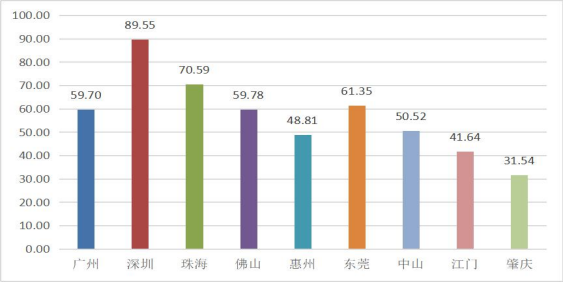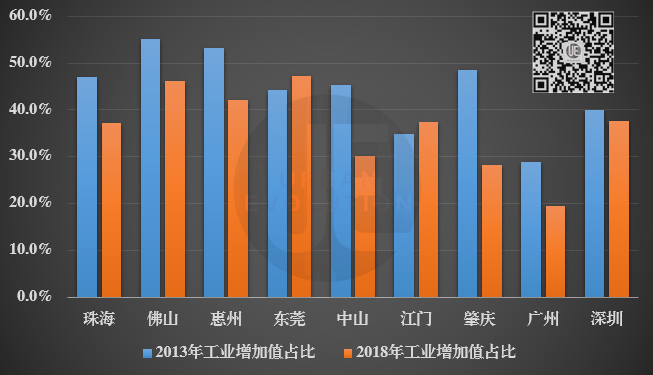The Greater Bay Area, which is close to 1/10 of the nation ’s industrial economy, is at a new crossroads.
Editor’s note: This article comes from Daily Economic News author: Yang abandon Africa, the authorized reprint
In 2020, manufacturing will remain an important issue for Chinese cities.
On January 3, the first issue of the first executive meeting of the State Council in 2020 focused on the steady growth of the manufacturing industry. In the previous year, the domestic manufacturing industry repeatedly showed “warning lights”-in the first half of last year, domestic manufacturing investment increased by 3.0% year-on-year, which was less than half (6.8%) of the same period in 2018. At the same time, according to the China Manufacturing Purchasing Managers Index (PMI) released by the National Bureau of Statistics, eight of the 12 months in 2019 are below the Rongkuai line.
The “industrial hollowing out” problem that has occurred in Europe, America, Japan and other countries has begun to hang above Chinese cities. In the research of Huang Qunhui, director of the Institute of Economics of the Chinese Academy of Social Sciences, today, those cities with a relatively high service industry are increasingly aware of the importance of manufacturing. “Now when developing their own strategies, cities hope to integrate manufacturing Keep it at 25%. “
The Greater Bay Area, which is close to 1/10 of the nation ’s industrial economic value added, stands at a new crossroads.
In the Outline of the Development Plan for the Guangdong-Hong Kong-Macao Greater Bay Area released earlier last year, the positioning of the Greater Bay Area as an “International Science and Technology Innovation Center with Global Influence” was included, which included the task of manufacturing transformation and upgrading; Guangdong is also constantly emphasizing “unswervingly stick to the manufacturing province.” However, in the first half of last year, except for Shenzhen in the 9 cities of the Pearl River Delta, the industrial growth rate of the remaining 8 cities decreased compared with the same period of the previous year.
Against this background, how will cities in the Greater Bay Area choose their next focus? Last week, the Guangdong Provincial Bureau of Statistics released a research report on innovation driven by the industrial economy. Combined with a series of actions last year, it may be possible to look at the development direction of the Greater Bay Area.

Industrial economic innovation-driven development index of the nine cities in the Pearl River Delta in 2018 Source of the chart: “Research on Industrial Economic Innovation-Driven Development of the Guangdong-Hong Kong-Macao Greater Bay Area”
Expanding capacity
How important is industry to stable economic growth?
Chief Economic Officer of GF SecuritiesAn economist, Shen Minggao, recently pointed out that although the increase in the proportion of service industries is the law of the development of large cities, too fast growth often leads to a decline in GDP growth. Investigating the reasons, according to the development experience of OECD countries, the labor force productivity level of the service industry is on average 40% lower than that of the manufacturing industry. Therefore, “to achieve a relatively fast GDP growth under a policy-neutral condition, we must find ways to prevent the service sector’s proportion from rising too quickly.”
This statement seems to hold true in the Greater Bay Area.
Comparison of the GDP growth rate and industrial added value growth rate of the nine cities in the Pearl River Delta in 2018:
Data source: “Research on Industrial Economy Innovation Driven Development in Guangdong, Hong Kong, Macao Greater Bay Area” and Statistical Communiqués by City
The report measures the industrial economic development of cities in the Greater Bay Area with the industrial added value in 2018 as an indicator. Comparing it with GDP growth rate, it can be found that among the 9 cities in the Pearl River Delta, including Zhuhai, Foshan, Jiangmen, Zhaoqing and Shenzhen, the growth rate of industrial added value in 2018 was higher than the GDP growth rate. In other words, for most cities in the Greater Bay Area, the key to driving GDP growth still comes from industry.
Not only that, in the Greater Bay Area, cities with better industrial performance tend to be more prominent in economic performance. The GDP growth rates of Zhuhai, Jiangmen, and Shenzhen, which have relatively high growth rates of industrial value added, are ranked first, third, and fourth among the nine cities. In Dongguan, which ranked second, the growth rate of industrial added value also reached 6.4%.
Last year, stabilizing the industrial “chassis” seemed particularly urgent in the Greater Bay Area, which is facing a new round of increasing demand. In November, Guangdong held a special conference to promote the development of high-quality manufacturing in the province. Li Xi, the secretary of the provincial party committee, emphasized once again that “the manufacturing industry should be established in the province”, and pointed out that “the high-quality development of the manufacturing industry should be used as a model for advancing the Greater Bay Area. The top priority of district construction. ”
Guangdong proposes to strengthen Guangzhou and Shenzhen’s “dual-core linkage, double-wing and double-flying”, and promote the formation of a reasonable manufacturing division and optimized development space layout—Guangzhou, known for its service industry, is included in the overall development of Guangdong’s manufacturing industry.
In fact, as the two central cities of the Greater Bay Area, Guangzhou and Shenzhen just constitute two different development models: In 2018, Shenzhen became the first city in China to exceed 900 billion yuan in industrial added value. “China Manufacturing The “First City” is well deserved; and although Guangzhou ’s industrial growth ranks behind, the service industry is “a ride in the dust”, not only occupying a high proportion of 71.7% of GDPIt is the first triangle city, and second only to Beijing among inland cities.
Last year, the development of “advanced manufacturing” became the key word for Guangzhou. In January, based on years of building a “manufacturing strong city”, Guangzhou included the creation of “advanced manufacturing strong city” into the six “strong city” construction goals. In March, Guangzhou took the lead in opening the expansion of high-tech zones, and the area of Guangzhou Science City nearly tripled. Subsequently, Shenzhen and Foshan also began to promote the expansion of high-tech zones.
But Guangzhou’s manufacturing problems still exist. Guangzhou’s industrial added value in 2018 was less than half that of Shenzhen, and even lost to Foshan. In terms of specific industry development, the leading industry automobile manufacturing industry has not yet returned to growth, and emerging industries such as robots have also been under pressure from development last year … All signs show that it will take time for the “dual-core” to fly together.
Upgrade files
Not long ago, after Foshan revealed that its GDP exceeded one trillion yuan last year, it was regarded as a development sample for manufacturing cities. On the same day, Liang Weidong, the secretary of the Dongguan Municipal Party Committee, mentioned that the GDP of Dongguan is expected to increase by 7% year-on-year in 2019, laying the foundation for the next step into the trillion mark.
Uncle Cheng just discussed the situation in Foshan last week, and now I mainly talk about Dongguan.
Although the economic aggregate is slightly inferior, Dongguan is not inferior in terms of manufacturing increments-not only does its industrial growth rate exceed Foshan, if it calculates the proportion of industrial economy to GDP in 5 years, Dongguan has increased from 44.2% in 2013 Rising to 47.2%, only Jiangmen is similar to the 9 cities in the Pearl River Delta. In the manufacturing market, this increase is also rare.
Comparison of the proportion of industrial value added to GDP in the 9 cities of the Pearl River Delta in the past 5 years:

Data source: “Research on Industrial Economy Innovation Driven Development in Guangdong, Hong Kong, Macao Greater Bay Area” and Statistical Communiqués by City
Since 2018, the establishment of Huawei’s R & D center has brought unprecedented attention to Dongguan, but this has not masked the problems caused by the rising factory rents over the years for the development of manufacturing. According to media reports, the repeated prohibition of the underground black factory leasing market has allowed the cost of renting a house to double in the shortest two years.
But the advantage of factory rent is precisely the “life gate” of Dongguan manufacturing.
In many people’s opinion, the growth of Dongguan’s manufacturing industry is inseparable from the spillover effect of Shenzhen’s enterprises. The foundry industry chain formed in the past, benefiting from the “three to one supplement”, has become the basis for undertaking Shenzhen’s spillover enterprises. Data show that Dongguan’s foreign trade dependence has fallen from a historical peak of 433.8% in 1995.